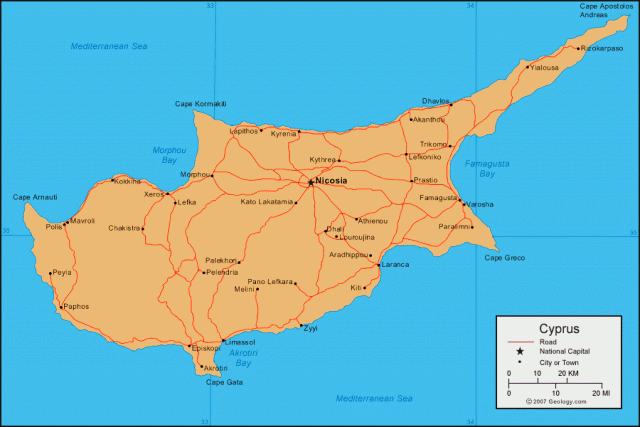Cyprus
Area 3,604 square mi (9,250 square km)
Population 1.153 million 2014
Capital Nicosia
Highest Point 6,407 ft (1,951 m)
Lowest Point 0 m
GDP $23.23 billion 2014
Primary Natural Resources copper, pyrites, asbestos.
CYPRUS IS AN island in the eastern MEDITERRANEAN SEA, 70 mi (113 km) south of TURKEY. For thousands of years, its civilization has been at the crossroads between Europe, Asia, and Africa. Today, Cypriots continue to play a role as a bridge between cultures, because of their island's proximity to the MIDDLE EAST, its cultural connections to GREECE, and its political status as one of the newest member states of the EUROPEAN UNION (EU).
Cyprus is politically divided, however, between the Greek-speaking majority in the southern part of the island and the self-proclaimed Turkish Republic of Northern Cyprus. This division has been in place since 1974 and remains unresolved despite pressure from the EU and the United Nations (UN).

The name Cyprus (Kypros in Greek) either derives from, or gives its name to one of the chief natural resources on the island: copper. This metal has been mined from the Troodos range since prehistoric times. The Troodos dominate the central and southern part of the island. The rest of Cyprus consists of the northern Kyrenia range, or Girne in Turkish, and the plain between the two ranges, the Mesaoria. There are also scattered plains along the southern coast. The Kyrenia is a narrow limestone ridge that extends far to the northeast of the mainland to form the Karpaz Peninsula. The Mesaoria is semiarid, sheltered from rains by the northern mountains. Wheat and barley are grown there, but require IRRIGATION for agriculture.
Significant rivers rise from the Troodos Mountains but are mostly dry in the summer. Severe deforestation has contributed to the island's water problem, particularly around the city of Nicosia, which occupies the central part of the Mesaoria. Nearly 200,000 people live in this city, called Lefkosa by Turkish Cypriots, who claim the northern part of the city as their capital. Other cities include Limassol, Larnaca, Famagusta, Paphos, and the ruined city of Salamis.
The diversity of building styles in these cities reflects the varieties of outside influences that have dominated Cypriot history since the second millennium B.C.E. Cyprus was a Roman then a Byzantine province for 1,000 years until it was taken over by Crusaders in the 12th century, notably the de Lusignan family, who set up a Catholic kingdom in opposition to the majority Orthodox population.
Venetian merchants, eager to secure their monopoly on trade in the eastern Mediterranean, purchased the island in 1489 but lost it to the Ottoman Turks in 1570. The Turks ruled Cyprus through a restored traditional Orthodox hierarchy, reinforcing the position of the church and the Greek language in Cypriot politics and culture. In 1878, control of the island was ceded to the British, eager to safeguard their shipping lanes to the Suez Canal. Great Britain formally annexed Cyprus in 1914. Independence was granted in 1960, but the island remains a member of the British Commonwealth, and the UNITED KINGDOM retains sovereignty over two military bases on the south and southeast coasts.
As early as the 1820s, Greek Cypriots expressed a strong desire for political union, or enosis, with the rest of Greece. It is this desire that has been at the root of the tension between Greeks and Turks on Cyprus ever since. The original 1960 constitution allowed for minority representation in government, but these stipulations were dropped in 1963. In 1974, a coup backed by Greece prompted military intervention from Turkey, and the country was divided into the southern and northern sections of today, divided by the so-called Green Line, patrolled by UN troops. In 1983 the Turkish area—roughly a third of the island declared itself to be the Turkish Republic of Northern Cyprus (TRNC), but it is recognized only by Turkey.
UN-led direct talks began in January 2002, and several proposals have been brought forward. A referendum on a plan set forth by UN Secretary-General Kofi Annan in April 2004 was approved by Turkish Cypriots but strongly rejected by the Greek population. It had been hoped that a settlement could be reached by the time of Cyprus's entry into the EU in May 2004. Many EU members were impressed, however, with Turkish willingness to settle their differences, which may in the long run lead to increased financial aid to the impoverished north.
The economy of Cyprus was severely disrupted by the division of 1974 but has recovered in the south, mostly through a huge increase in tourism. Tourism and other service industries today contribute 76 percent of the gross domestic product and employ 70 percent of the labor force. Millions of tourists per year come for Cyprus's clean waters and relatively undeveloped beaches. Southern Cyprus has also become a center for international business and offshore banking, due to its proximity to the Middle East, and its educated, English-speaking population. The north has had less of a recovery and continues to rely heavily on financial support from Turkey.